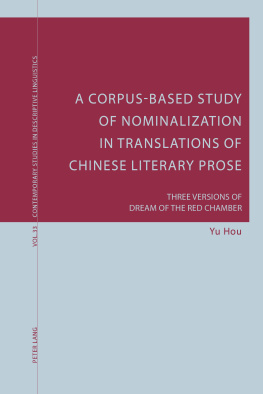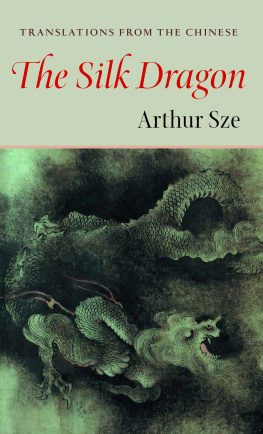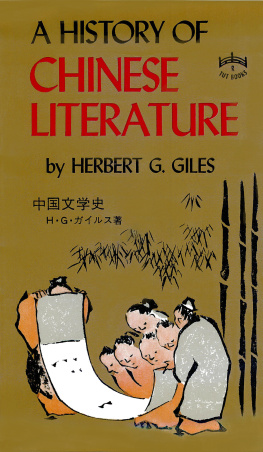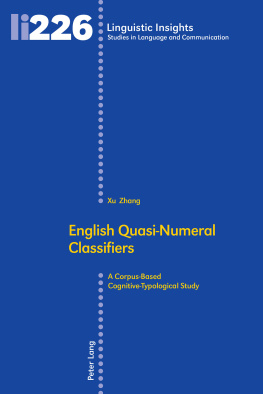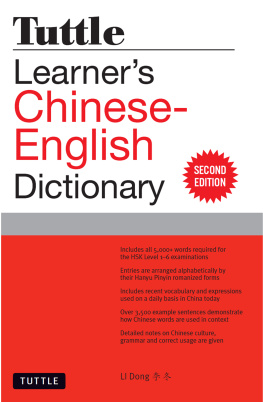CONTEMPORARY STUDIES IN DESCRIPTIVE LINGUISTICS
VOL. 33
Edited by
DR GRAEME DAVIS & KARL A. BERNHARDTPETER

PETER LANG
Oxford Bern Berlin Bruxelles Frankfurt am Main New York Wien
Yu Hou
A CORPUS-BASED STUDY OF NOMINALIZATION IN TRANSLATIONS OF CHINESE LITERARY PROSE
THREE VERSIONS OF DREAM OF THE RED CHAMBER

PETER LANG
Oxford Bern Berlin Bruxelles Frankfurt am Main New York Wien
Bibliographic information published by Die Deutsche Nationalbibliothek.
Die Deutsche Nationalbibliothek lists this publication in the Deutsche Nationalbibliografie; detailed bibliographic data is available on the Internet at http://dnb.d-nb.de.
A catalogue record for this book is available from the British Library.
Library of Congress Control Number: 2014945679
This monograph has been supported by a grant from the Humanities and Social Sciences Research Project of the Chinese Ministry of Education (Grant No. 12YJC740030) and a grant from the Humanities and Social Sciences Research Project of Hebei Province, China (Grant No. HB14YY006).
ISSN 1660-9301
ISBN 978-3-0343-1815-0 (print)
ISBN 978-3-0353-0652-1 (eBook)
Peter Lang AG, International Academic Publishers, Bern 2014
Hochfeldstrasse 32, CH-3012 Bern, Switzerland
info@peterlang.com, www.peterlang.com, www.peterlang.net
All rights reserved.
All parts of this publication are protected by copyright.
Any utilisation outside the strict limits of the copyright law, without the permission of the publisher, is forbidden and liable to prosecution.
This applies in particular to reproductions, translations, microfilming, and storage and processing in electronic retrieval systems.
This publication has been peer reviewed.
Contents
| The number of NOMs as a condenser of temporal clauses in the three versions of HLM |
| The number of NOMs as a condenser of causal clauses in the three versions of HLM |
| The number of NOMs as a condenser of purposive clauses in the three versions of HLM |
| The number of NOMs as a condenser of conditional clauses in the three versions of HLM |
| The number of NOMs as a condenser of concessive clauses in the three versions of HLM |
| The number of NOMs as a condenser of nominal that-clauses in the three versions of HLM |
| The number of NOMs as a condenser of adverbial clauses in the three versions of HLM |
| The number of NOMs as complement of verbs in the three versions of HLM |
| The number of NOMs as complement of adjectives in the three versions of HLM |
| The number of NOMs as complement of nouns in the three versions of HLM vii | viii |
| viii | ix |
| Empirical studies of ex/implicitation phenomena in translation |
| Names of English translations of Chinese literary prose works and English literary prose works |
| NOMs as a condenser of temporal clauses |
| Most frequently used collocations in the most frequently used types of constructions |
| NOMs as a condenser of causal clauses |
| NOMs as a condenser of purposive clauses |
| NOMs as a condenser of conditional clauses |
| NOMs as a condenser of concessive clauses |
| NOMs as adverbial |
| NOMs in the position of subject |
| NOMs in the position of object |
| Frequently used collocations with NOMs in the position of object |
| Quantitative results of NOMs in the three English versions of HLM |
| Quantitative results of formal constructions used in the three English versions of HLM |
| Quantitative results of NOMs used by Mr Yang in his English translated and original works |
| Quantitative results of periphrastic predicate structures in the three versions of HLM ix | x |
| Quantitative results of NOMs in English translations of other Chinese literary prose works |
| Quantitative results of NOMs in the five English literary prose works |
| A comparison of NOMs in the English translations of Chinese literary prose works and English literary prose works x | xi |
| A | Adverb |
| AM | Aspect Marker |
| AP | Adverbial Phrase |
| ATM | Attributive Marker |
| C | Complement |
| CM | Complement Marker |
| EFS | Explicit Finite Structure |
| O | Object |
| PA | Particle |
| PM | Passive Marker |
| PP | Prepositional Phrase |
| RP | Reflexive Pronoun |
| S | Subject |
| V | Verb |
| VP | Verbal Phrase xi | xii |
| xii | 1 |
The present study sets out to make a corpus-based, linguistic, descriptive and explanatory investigation of nominalization in English translations of Chinese literary prose (mainly based on three complete English versions of the eighteenth-century Chinese 120-chapter novel Hong Lou Meng (, literally translated as Red Chamber Dream) (to be abbreviated as HLM hereinafter). The study chooses to follow Lees (1963) in defining English nominalization as a nominalized transform of a finite verbal form and focus on three categories of the NOM as a representative of the process of nominalization (i.e. Gerundive NOM, Derived NOM, and Zero-derived NOM). This study regards nominalization as one of the manifestations of implicitation in translation.
1.1 Research rationale
Since the 1990s, translation scholars have embarked on using techniques and tools of corpus linguistics to investigate translation, thus gradually ushering translation studies into a corpus-based era. One of the most prominent contributions corpus-based translation studies has made so far is the research of what Vanderauwera (1985) initially identified as translation universals. Translation universals are linguistic features which typically occur in translated text[s] rather than original utterances and which are not the result of interference from specific linguistic systems (Baker 1993: 243). As a potential candidate for the status of translation universal, explicitation is claimed as one of the most thoroughly studied phenomena in translation studies (Perego 1 | 2 2003: 68; Gumul 2006: 171). It is defined as a stylistic technique which consists of making explicit in the target language what remains implicit in the source language (Vinay and Darbelnet 1995: 342). However, the international body of literature on explicitation far outweighs that on implicitation. As Klaudy and Karoly (2005: 13) pointed out, [i]mplicitation is treated as a stepbrother of explicitation: it is generally mentioned merely incidentally.
Nominalization is generally considered one of the most widely studied linguistic phenomena. The development of the theory of English nominalization, to a large extent, informs the whole process of the development of English linguistics. Major linguistic schools have addressed, in different degrees, the issue of English nominalization in their representative works. In the Prague School, Mathesius (1975 [1961]) approaches it from the perspective of complex condensation of the sentence. In transformational-generative linguistics, whether it belongs to part of the syntax (represented by Lees (1963) transformational approach) or to part of the lexicon (represented by Chomskys (1971) early lexicalist approach) used to be a famous debate. Systemic-functional linguists focus on its various context-specific functions. According to Radovanovic (2001: 434), it is a general characteristic of nominalizations that they appear more often as a standard feature of some special functional styles/registers of language use, particularly of those
Next page
